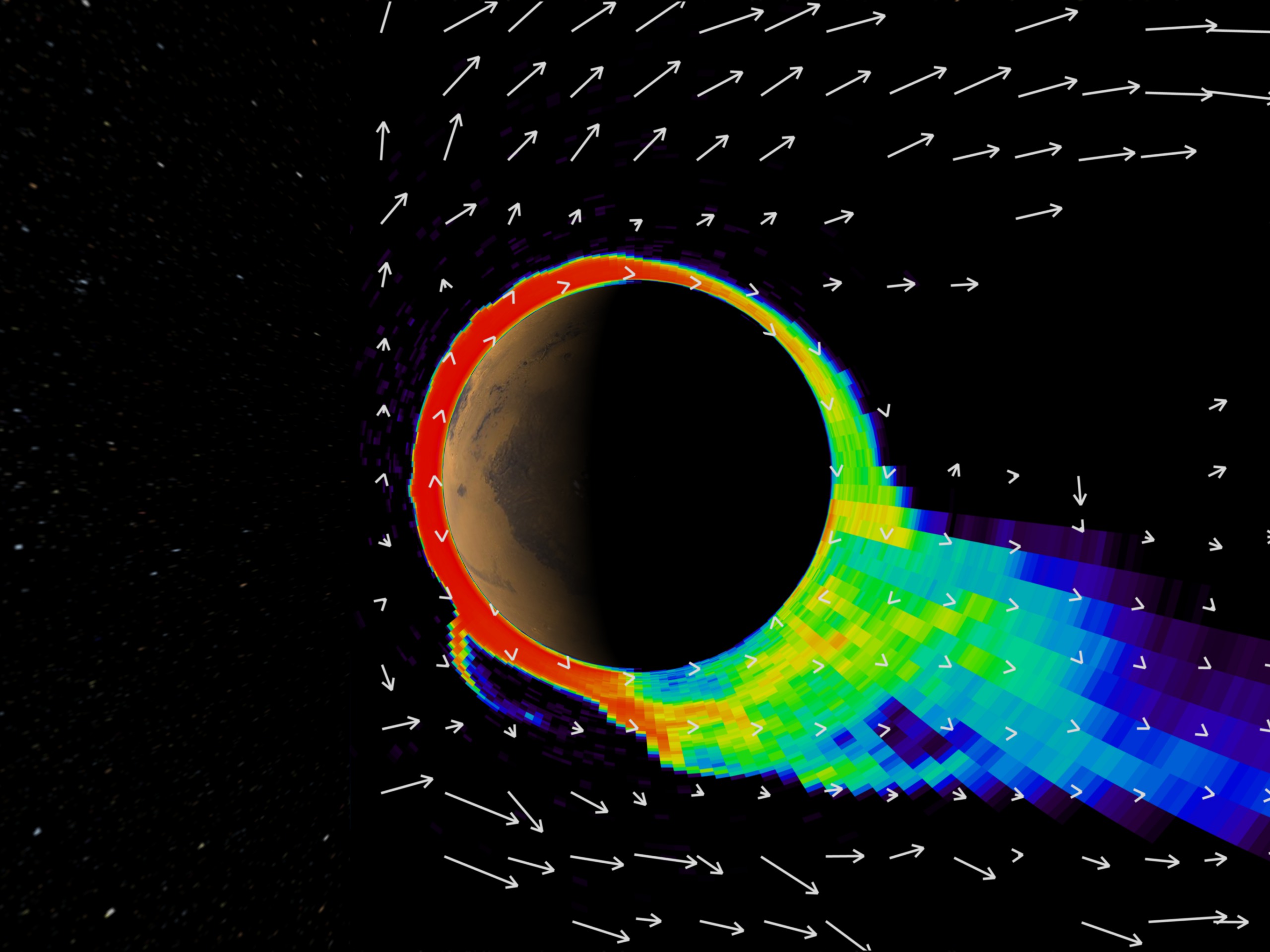Sun
Planets and Moons
ID: 2962
Mars possesses no significant intrinsic magnetic field. The absence of magnetic protection allows the supersonic solar wind flow to directly interact with the Martian ionosphere (an almost fully ionized region of the Mars upper atmosphere). When the velocity of the solar wind increases, the Martian ionosphere is compressed and the ionopause (a boundary layer between the ionosphere and the solar wind) is displaced to lower altitudes. The ions of planetary origin such as O+ and O2+ escape from the upper atmosphere of Mars due to solar wind induced scavenging processes. Many more planetary ions are scavenged when the solar wind velocity increases because a much larger part of the planetary atmosphere is exposed to the solar wind as the ionopause is pushed inwards towards the planetary surface. There are some indications that the solar wind flow, as well as the Sun's x-ray and extreme ultraviolet radiation, were much more intense early in solar system history. It is thought that some 3.5 billion years ago, these extreme interplanetary conditions may have caused a much larger rate of water loss from the Martian atmosphere. We estimate that the solar wind scavenging pictured here under the extreme conditions in the early solar system would have caused the loss of a 10 meter global equivalent ocean layer from Mars over the last 3.5 billion years. This loss is less than one tenth of the 156 m global equivalent ocean layer estimated to have existed on early Mars using the Mars Global Surveyor observations. Arrows represent the flow of the ions of planetary origin. The colors represent the density of the Martian ionosphere, with red as high and blue as low.



Computer Simulations of the Martian Atmosphere Interacting with the Solar Wind



Visualization Credits
Tom Bridgman (Global Science and Technology, Inc.): Lead Animator
Marte Newcombe (GST): Animator
Cindy Starr (Global Science and Technology, Inc.): Visualizer
Naoki Terada (Solar-Terrestrial Environment Laboratory; Nagoya University; Japan): Scientist
Hiroyuki Shinagawa (Solar-Terrestrial Environment Laboratory; Nagoya University; Japan): Scientist
William Steigerwald (NASA/GSFC): Writer
Marte Newcombe (GST): Animator
Cindy Starr (Global Science and Technology, Inc.): Visualizer
Naoki Terada (Solar-Terrestrial Environment Laboratory; Nagoya University; Japan): Scientist
Hiroyuki Shinagawa (Solar-Terrestrial Environment Laboratory; Nagoya University; Japan): Scientist
William Steigerwald (NASA/GSFC): Writer
Please give credit for this item to:
NASA/Nagoya University
NASA/Nagoya University
Short URL to share this page:
https://svs.gsfc.nasa.gov/2962
This item is part of this series:
Halloween 2003 Solar Storms
Keywords:
SVS >> Mars
SVS >> Solar Wind
DLESE >> Space science
GCMD >> Earth Science >> Atmosphere
SVS >> Space Weather
SVS >> For Educators
SVS >> Solar Activity
SVS >> Sun-Mars Interactions
SVS >> Solar System >> Planets >> Mars >> Ionosphere
NASA Science >> Sun
NASA Science >> Planets and Moons
GCMD keywords can be found on the Internet with the following citation: Olsen, L.M., G. Major, K. Shein, J. Scialdone, S. Ritz, T. Stevens, M. Morahan, A. Aleman, R. Vogel, S. Leicester, H. Weir, M. Meaux, S. Grebas, C.Solomon, M. Holland, T. Northcutt, R. A. Restrepo, R. Bilodeau, 2013. NASA/Global Change Master Directory (GCMD) Earth Science Keywords. Version 8.0.0.0.0
https://svs.gsfc.nasa.gov/2962
This item is part of this series:
Halloween 2003 Solar Storms
Keywords:
SVS >> Mars
SVS >> Solar Wind
DLESE >> Space science
GCMD >> Earth Science >> Atmosphere
SVS >> Space Weather
SVS >> For Educators
SVS >> Solar Activity
SVS >> Sun-Mars Interactions
SVS >> Solar System >> Planets >> Mars >> Ionosphere
NASA Science >> Sun
NASA Science >> Planets and Moons
GCMD keywords can be found on the Internet with the following citation: Olsen, L.M., G. Major, K. Shein, J. Scialdone, S. Ritz, T. Stevens, M. Morahan, A. Aleman, R. Vogel, S. Leicester, H. Weir, M. Meaux, S. Grebas, C.Solomon, M. Holland, T. Northcutt, R. A. Restrepo, R. Bilodeau, 2013. NASA/Global Change Master Directory (GCMD) Earth Science Keywords. Version 8.0.0.0.0











